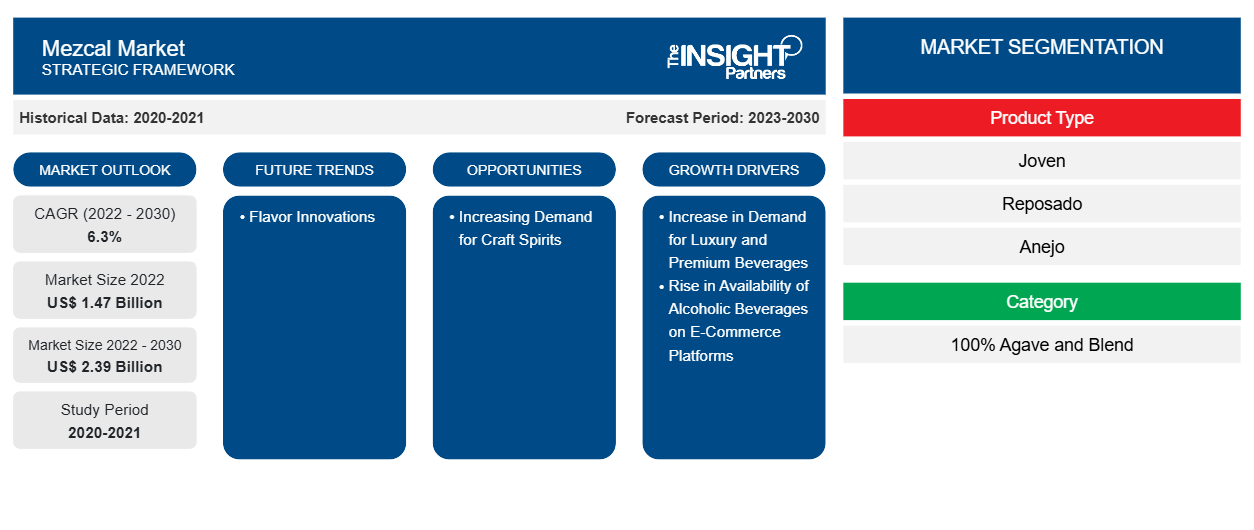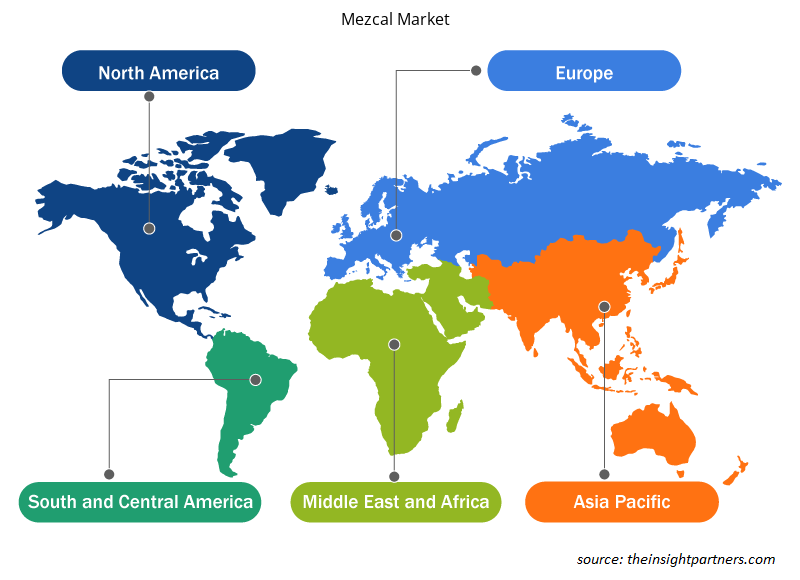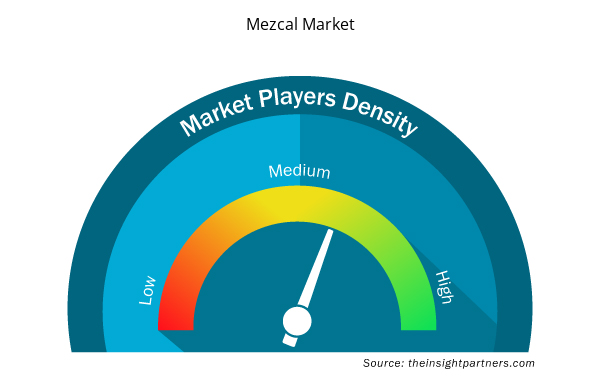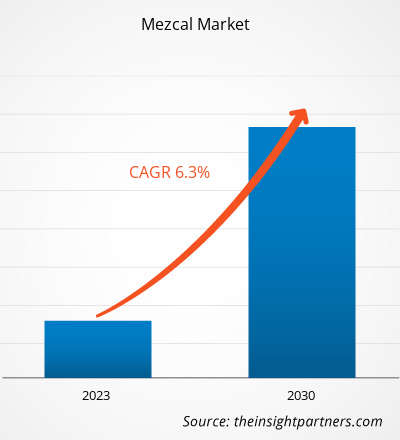[Research Report] The mezcal market size was valued at US$ 1,469.17 million in 2022 and is expected to reach US$ 2,393.57 million by 2030; it is estimated to register a CAGR of 6.3% from 2022 to 2030.
Market Insights and Analyst View:
Mezcal is a distinctive Mexican spirit made from agave plants, primarily in the Oaxaca region. Unlike tequila, which is a type of mezcal made exclusively from blue agave, mezcal can be produced from various agave species, giving it a broader range of flavors and aromas. The surge in demand for mezcal can be attributed to its artisanal production methods, unique smoky flavor, and the growing appreciation for craft spirits. Consumers are increasingly seeking authenticity and diversity in their drinking experiences, which has led to mezcal gaining popularity among adventurous spirits enthusiasts and mixologists alike. Its cultural heritage and traditional production techniques have also contributed to its appeal, making it a sought-after choice for those looking to explore the rich world of agave-based spirits.
Growth Drivers and Challenges:
The rising demand for luxury and premium beverages has emerged as a driving force for the Mezcal market. One significant catalyst for this trend is the increase in the disposable income of consumers. As people's earnings have grown, they are more inclined to allocate a portion of their budget to indulging in high-end spirits such as Mezcal. This has opened up opportunities for premium Mezcal brands to thrive as consumers seek distinctive, elevated drinking experiences. Additionally, the influence of millennials cannot be understated. This demographic cohort has shown a particular penchant for spending on high-end beverages, driven by a desire for quality, authenticity, and unique flavor profiles. Mezcal aligns perfectly with these preferences, offering a handcrafted and artisanal product that resonates with the millennial demographic, contributing significantly to the surge in demand.
Customize This Report To Suit Your Requirement
You will get customization on any report - free of charge - including parts of this report, or country-level analysis, Excel Data pack, as well as avail great offers and discounts for start-ups & universities
Mezcal Market: Strategic Insights

- Get Top Key Market Trends of this report.This FREE sample will include data analysis, ranging from market trends to estimates and forecasts.
Customize This Report To Suit Your Requirement
You will get customization on any report - free of charge - including parts of this report, or country-level analysis, Excel Data pack, as well as avail great offers and discounts for start-ups & universities
Mezcal Market: Strategic Insights

- Get Top Key Market Trends of this report.This FREE sample will include data analysis, ranging from market trends to estimates and forecasts.
Moreover, the evolution of consumer preferences plays a pivotal role in driving the Mezcal market. Modern consumers increasingly seek unique and sophisticated spirits that go beyond the ordinary. With its intricate production process, smoky notes, and distinct flavors, Mezcal aligns well with this shift. It has become a symbol of refined taste and has gained a reputation as a premium beverage choice, attracting discerning consumers looking for a more elevated drinking experience.
The burgeoning cocktail culture has further contributed to Mezcal's ascent in the luxury beverage market. Mixologists and bartenders have embraced Mezcal as a versatile and premium ingredient for crafting unique and innovative cocktails. Its smoky and complex flavors add depth and character to drinks, making it a sought-after choice in upscale bars and restaurants. This has heightened Mezcal's visibility and spurred consumer interest in recreating these upscale cocktail experiences at home, further driving demand.
Lastly, the perception of Mezcal as a luxury product has been amplified by effective marketing strategies and distinctive packaging. Premium Mezcal brands have invested in sophisticated branding highlighting the product's artisanal origins, emphasizing its exclusivity. This marketing approach has attracted consumers looking for status symbols and unique gifting options, bolstering the demand for Mezcal in the luxury spirits market.
However, there are strict regulations that govern Mezcal production, labeling, and certification in Mexico. The Denomination of Origin for Mezcal, which protects Mezcal's geographical origin and traditional production methods, imposes a set of rules that can be burdensome for producers. For instance, to be labeled as "Mezcal," the spirit must be made from specific varieties of agave plants, primarily found in some areas of Mexico, and produced using traditional methods. The traditional method includes cooking in earthen pits or clay ovens, milling by hand, fermentation in stone or organic pits, and distillation with direct fire under copper or clay pots. Meeting these requirements can be costly or time-consuming, limiting the ability of smaller producers to enter the market and compete effectively.
Another regulatory challenge relates to certification and labeling. Producers must adhere to rigorous quality standards and undergo certification processes to carry the official "Mezcal" label. This can be a barrier for smaller, local producers who may not have the resources to navigate these bureaucratic procedures or invest in the necessary equipment and facilities. Furthermore, strict rules about labeling and advertising include specifying the type of agave used, the region of production, and the distillation process. Any deviations from these rules can lead to legal issues, making it essential for producers to comply meticulously. These regulatory constraints can restrict market entry, hinder innovation, and create compliance costs, particularly for small Mezcal producers.
Report Segmentation and Scope:
The global mezcal market is segmented on the basis of product type, category, distribution channel, and geography. Based on product type, the market is categorized into joven, reposado, anejo, and others. By category, the market is bifurcated into 100% agave and blend. By distribution channel, the market is categorized into supermarkets and hypermarkets, specialty stores, online retail, and others. By geography, the global mezcal market is broadly segmented into North America, Europe, Asia Pacific, the Middle East & Africa, and South & Central America.
Segmental Analysis:
Based on product type, the market is categorized into joven, reposado, anejo, and others. The reposado segment is expected to register the highest CAGR during 2022–2030. Reposado, which translates to "rested" in Spanish, represents a middle ground between the youthful boldness of joven and the aged complexity of anejo mezcal. It undergoes a relatively short aging process of two months to one year in oak barrels. This aging imparts a mellower character to the spirit, smoothing out some of the agave's sharper edges. While retaining the core agave flavors, reposado mezcal develops additional nuances, such as hints of vanilla, caramel, and wood. Its surging demand is due to its ability to balance the unaged vibrancy of joven and the refined complexity of anejo, making it a preferred choice for those seeking a smoother and more approachable mezcal experience.
Regional Analysis:
The mezcal market is segmented into five key regions: North America, Europe, Asia Pacific, South & Central America, and the Middle East & Africa. North America dominated the global mezcal market, and the regional market accounted for US$ 612.20 million in 2022. Europe is a second major contributor, holding more than 29% share of the global market. Asia Pacific is expected to register a considerable CAGR of over 7% during 2022–2030. Mezcal is gaining popularity among consumers in Asian countries such as China, India, Japan, and Australia. This consumer shift toward mezcal is mainly attributed to the rising health concerns. The rising preference for luxurious alcoholic beverages has increased the demand for mezcal, which is anticipated to propel the market growth in APAC.
Mezcal Market Regional Insights
The regional trends and factors influencing the Mezcal Market throughout the forecast period have been thoroughly explained by the analysts at Insight Partners. This section also discusses Mezcal Market segments and geography across North America, Europe, Asia Pacific, Middle East and Africa, and South and Central America.

- Get the Regional Specific Data for Mezcal Market
Mezcal Market Report Scope
| Report Attribute | Details |
|---|---|
| Market size in 2022 | US$ 1.47 Billion |
| Market Size by 2030 | US$ 2.39 Billion |
| Global CAGR (2022 - 2030) | 6.3% |
| Historical Data | 2020-2021 |
| Forecast period | 2023-2030 |
| Segments Covered |
By Product Type
|
| Regions and Countries Covered | North America
|
| Market leaders and key company profiles |
Mezcal Market Players Density: Understanding Its Impact on Business Dynamics
The Mezcal Market market is growing rapidly, driven by increasing end-user demand due to factors such as evolving consumer preferences, technological advancements, and greater awareness of the product's benefits. As demand rises, businesses are expanding their offerings, innovating to meet consumer needs, and capitalizing on emerging trends, which further fuels market growth.
Market players density refers to the distribution of firms or companies operating within a particular market or industry. It indicates how many competitors (market players) are present in a given market space relative to its size or total market value.
Major Companies operating in the Mezcal Market are:
- Casa Agave Ltd
- Quiquiriqui Mezcal Ltd
- Davide Campari Milano NV
- Gente de Mezcal SA de CV
- Bacardi-Martini BV
Disclaimer: The companies listed above are not ranked in any particular order.

- Get the Mezcal Market top key players overview
COVID-19 Pandemic Impact:
The COVID-19 pandemic initially hindered the global mezcal market due to the shutdown of manufacturing units, shortage of labor, disruption of supply chains, and financial instability. The disruption of various industries due to the economic slowdown caused by the COVID-19 outbreak restrained the mezcal supply. Various liquor stores were closed. However, businesses started gaining ground as previously imposed limitations were eased across various countries. Moreover, the introduction of COVID-19 vaccines by governments of different countries eased the situation, leading to a rise in business activities worldwide. Several markets, including the mezcal market, reported growth after the ease of lockdowns and movement restrictions.
Competitive Landscape and Key Companies:
Casa Agave Ltd, Quiquiriqui Mezcal Ltd, Davide Campari Milano NV, Gente de Mezcal SA de CV, Bacardi-Martini BV, Diageo Plc, Pernod Ricard SA, Meanwhile Drinks Ltd, Proximo Spirits Inc, and Madre Mezcal Inc are among the prominent players operating in the global mezcal market.
- Historical Analysis (2 Years), Base Year, Forecast (7 Years) with CAGR
- PEST and SWOT Analysis
- Market Size Value / Volume - Global, Regional, Country
- Industry and Competitive Landscape
- Excel Dataset


- Lyophilization Services for Biopharmaceuticals Market
- Social Employee Recognition System Market
- EMC Testing Market
- Hair Extensions Market
- Real-Time Location Systems Market
- Dealer Management System Market
- Passport Reader Market
- Neurovascular Devices Market
- Space Situational Awareness (SSA) Market
- Legal Case Management Software Market

Report Coverage
Revenue forecast, Company Analysis, Industry landscape, Growth factors, and Trends

Segment Covered
Product Type, Category, and Distribution Channel

Regional Scope
North America, Europe, Asia Pacific, Middle East & Africa, South & Central America

Country Scope
This text is related
to country scope.
Frequently Asked Questions
The major players operating in the global mezcal market are Casa Agave Ltd, Quiquiriqui Mezcal Ltd, Davide Campari Milano NV, Gente de Mezcal SA de CV, Bacardi-Martini BV, Diageo Plc, Pernod Ricard SA, Meanwhile Drinks Ltd, Proximo Spirits Inc, and Madre Mezcal Inc among others.
In 2022, North America region accounted for the largest share of the global mezcal market. The North American region comprises developed and developing economies such as the U.S. and Canada, and Mexico. Several mezcal breweries have a strong foothold in the North American region. Key market players in the North American mezcal market include E.L. Silencio Holdings, Inc., Mezcal Vago, Ilegal Mezcal, Rey Campero, and many others. These breweries are constantly working towards innovation and developing different varieties of mezcal with improved tastes and qualities to attract new consumers and widen the consumer base in the region. The export of mezcal to several countries across North America will contribute to the rise in demand for mezcal in the region. Innovative programs aimed at marketing the product across North America will increase demand for mezcal in North America.
The rising demand for luxury and premium beverages has emerged as a driving force for the Mezcal market. One significant catalyst for this trend is the increase in the disposable income of consumers. As people's earnings have grown, they are more inclined to allocate a portion of their budget to indulging in high-end spirits such as Mezcal. This has opened up opportunities for premium Mezcal brands to thrive as consumers seek distinctive, elevated drinking experiences. Additionally, the influence of millennials cannot be understated. This demographic cohort has shown a particular penchant for spending on high-end beverages, driven by a desire for quality, authenticity, and unique flavor profiles. Mezcal aligns perfectly with these preferences, offering a handcrafted and artisanal product that resonates with the millennial demographic, contributing significantly to the surge in demand. Moreover, the evolution of consumer preferences plays a pivotal role in driving the Mezcal market. Modern consumers increasingly seek unique and sophisticated spirits that go beyond the ordinary. With its intricate production process, smoky notes, and distinct flavors, Mezcal aligns well with this shift. It has become a symbol of refined taste and has gained a reputation as a premium beverage choice, attracting discerning consumers looking for a more elevated drinking experience.
Based on product type, the market is categorized into joven, reposado, anejo, and others. The reposado segment is expected to register the highest CAGR during 2022–2030. Reposado, which translates to "rested" in Spanish, represents a middle ground between the youthful boldness of joven and the aged complexity of anejo mezcal. It undergoes a relatively short aging process of two months to one year in oak barrels. This aging imparts a mellower character to the spirit, smoothing out some of the agave's sharper edges. While retaining the core agave flavors, reposado mezcal develops additional nuances, such as hints of vanilla, caramel, and wood. Its surging demand is due to its ability to balance the unaged vibrancy of joven and the refined complexity of anejo, making it a preferred choice for those seeking a smoother and more approachable mezcal experience.
Based on category, the mezcal market is segmented into 100% agave and blend. 100% agave category represents mezcal made exclusively from agave plants, with no other sugar sources added during fermentation or distillation. It embodies the traditional and authentic spirit of mezcal production, highlighting various agave species' unique flavors and characteristics. The demand for 100% agave mezcal has been steadily increasing due to consumer's growing appreciation for pure and unadulterated spirits. Discerning drinkers seek the true essence of mezcal, valuing the rich diversity of agave flavors and the dedication of mezcaleros in preserving centuries-old production methods. This category's surge in popularity can be attributed to a desire for transparency and authenticity in the mezcal market as consumers become more educated about the significance of 100% agave labeling.
Mezcal producers are increasingly experimenting with different agave varietals, aging methods, and flavor infusions, which cater to changing consumer preferences and provide unique selling points for their brands. One example of flavor innovation is the use of different agave varieties. While espadin agave is the most commonly used for Mezcal production, some producers explore lesser-known agave types such as tobala, tepextate, and arroqueno. Each agave variety brings its distinct flavor profile to the Mezcal, from earthy and vegetal to fruity and floral notes. This diversity allows consumers to explore various flavors within the Mezcal category, catering to various palate preferences.
Another avenue of innovation involves the aging process. Mezcal aging can occur in various containers, such as oak barrels, glass, or clay pots. Producers experiment with different aging periods and container types to impart unique flavors and aromas. For instance, extended aging in oak barrels can introduce hints of vanilla and caramel, enhancing the complexity of the final product. This approach mirrors the techniques often seen in the whiskey and wine industries, offering a bridge for consumers transitioning from those spirits to Mezcal.
Trends and growth analysis reports related to Food and Beverages : READ MORE..
The List of Companies - Mezcal Market
- Casa Agave Ltd
- Quiquiriqui Mezcal Ltd
- Davide Campari Milano NV
- Gente de Mezcal SA de CV
- Bacardi-Martini BV
- Diageo Plc
- Pernod Ricard SA
- Meanwhile Drinks Ltd
- Proximo Spirits Inc
- Madre Mezcal Inc

 Get Free Sample For
Get Free Sample For